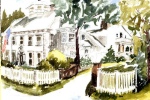SALMON RIVER STATE FOREST
SALMON RIVER STATE FOREST
Get a glimpse of earlier times as you walk through one of Connecticut's covered bridges. Enjoy a day of fishing and a picnic along the Salmon River.
The first purchase of lands which comprise the Salmon River Forest was made by the State Board of Fisheries and Game in 1934. The Forest now contains nearly 6,000 acres located in the towns of Hebron, Marlborough Colchester, East Haddam, and East Hampton. Included in the forest area is 1,300 acres that are leased from the United States Government.The important tributaries of the Salmon River are the Dickenson Stream, Blackledge River, Jeremy River, and Fawn Brook, all of which enter the main river above Comstock Bridge. The Salmon River joins the Connecticut River a short distance from East Haddam. It is probably the largest stream and watershed whose sources and mouth are entirely within the limits of the State.One of the early and notable settlers in this area was John Carrier who was reputed to be the executioner of Charles the First and who fled England when the monarchy was restored. His family name still exists on the land records of the area.The towns in this area were settled during the early part of 1700 and were typical of the early New England settlements. Streams and ponds were dammed to furnish waterpower for grist mills, tanneries, and later paper mills.The Salmon River and its tributaries each had more mills trying to operate by the middle of the nineteenth century than the water supply could support during periods of minimal precipitation. At North Westchester, for example, during low periods the grist mills had to operate at night and the paper mill by the day.The easy accessibility of the Salmon River and its tributaries has made the forest a very popular fishing area.
Connecticut has made state parks, forests, trails, historic sites and beaches more accessible to our residents so they can enjoy the many attractions and beauty they offer. Under the Passport to the Parks program, parking fees are now eliminated at Connecticut State Parks for those with Connecticut registered vehicles. You can view the
CONNECTICUT PASSPORT TO THE PARKS web page to learn more.

BBs / Inns
Located along the CT Shoreline midway between New York City and Boston, and only one hour from Hartford, with tons of local attractions both on the Long Island Sound and the Connecticut River.
17.8 miles from park*
The first purchase of lands which comprise the Salmon River Forest was made by the State Board of Fisheries and Game in 1934. The Forest now contains nearly 6,000 acres located in the towns of Hebron, Marlborough Colchester, East Haddam, and East Hampton. Included in the forest area is 1,300 acres that are leased from the United States Government.
The important tributaries of the Salmon River are the Dickenson Stream, Blackledge River, Jeremy River, and Fawn Brook, all of which enter the main river above Comstock Bridge. The Salmon River joins the Connecticut River a short distance from East Haddam. It is probably the largest stream and watershed whose sources and mouth are entirely within the limits of the State.One of the early and notable settlers in this area was John Carrier who was reputed to be the executioner of Charles the First and who fled England when the monarchy was restored. His family name still exists on the land records of the area.
The towns in this area were settled during the early part of 1700 and were typical of the early New England settlements. Streams and ponds were dammed to furnish waterpower for grist mills, tanneries, and later paper mills.The Salmon River and its tributaries each had more mills trying to operate by the middle of the nineteenth century than the water supply could support during periods of minimal precipitation. At North Westchester, for example, during low periods the grist mills had to operate at night and the paper mill by the day.The easy accessibility of the Salmon River and its tributaries has made the forest a very popular fishing area.



